Power Quality Phenomena in Electric Railway Power Supply Systems: An Exhaustive Framework and Classification
Abstract
1. Introduction
2. Power Quality Phenomena in ERPS
2.1. System Unbalance
- IEEE std 112-1991
- IEC 60034-26
- ANSI/NEMA Standard MG1-1993
2.2. Harmonics
2.2.1. Low Order Harmonics
- Background Harmonics
- Train Internal Harmonics
- DC Substation Harmonics
2.2.2. Inter-Harmonics
2.2.3. Low Frequency Oscillation
- LFO in RFC based ERPS
- LFO in ERPS without RFC
- Irregular LFO
2.2.4. Harmonic Resonance
- Parallel HR
- Series HR
2.2.5. Harmonic Instabilities
2.3. Reactive Power and Low Power Factor
2.4. Transient Events
2.4.1. Impulsive Transients (ImT)
- Lightning
- Switching of circuit breakers
- Abnormal changes in tractive efforts
2.4.2. Oscillatory Transients (OsT)
- Changing in operational condition and modulation patterns
- Sliding contact and pantograph jump over OCS
- Inrush current of the locomotive transformer
- Capacitor bank energization
2.5. Short Duration rms Variations
2.5.1. Voltage Dips (Sag)
- During the fault occurrence in the line.
- The high value of starting current absorbed by traction motors.
- Sudden load changes or supplying high-power locomotives.
- TPSS transformers energization.
- The motor blocking caused by the segregation of pantograph and OCS in the vibration situations or neutral sections.
- TPSS equipment triggering such as lightning, escalator, air-conditioners, heaters, etc.
2.5.2. Voltage Rises (Swell)
- Sudden load changing or supplying high-power locomotives.
- TPSS transformers de-energization.
- The motor blocking caused by the segregation of pantograph and OCD in the vibration situations or neutral sections.
- TPSS equipment ceasing such as lightning, escalator, air-conditioners, heaters, etc.
- De-energization or disconnecting of high-power loads.
2.5.3. Interruption (InR)
2.6. Long Duration rms
2.6.1. Overvoltage (OvG)
- Voltage increase in the OCS in the case of regenerative braking and lack of consumer trains in the network.
- The interlinkage of system harmonics and pantograph impedance and created resonances.
- System instabilities.
- Oscillations happening in the onboard controllers.
- Automatic passing of neutral zones.
- Impedance unconformity at the inverter and traction motor terminals.
- Lightening overvoltage.
- Switching or other atmospheric phenomena.
- Functioning of split-phase breakers in case of phase changing procedure.
2.6.2. Undervoltage (UvG)
2.6.3. Interruption Sustained (InRS)
2.7. Voltage Fluctuation (Flicker)
2.8. Waveform Distortion
2.8.1. DC offset
2.8.2. Notch
2.8.3. Noise
2.9. Electromagnetic Interference (EMI)
- The induced interference voltage because of the inductive/capacitive coupling of three-phase ac power grid transmission lines nearby to the OCS and TPSS.
- The induced interference voltage by inductive/capacitive coupling of OCS conductors.
- The conducted interference between rails and signaling systems/track circuits.
- The inducted/radiated interference originated by pantograph arcing.
2.9.1. Conducted EMI
2.9.2. Inducted EMI
2.9.3. Electrostatic/Capacitance EMI
2.9.4. Radiated EMI
3. Investigation of PQ Phenomena Occurrence Based on ERPS Type
4. Discussion and Classification
5. Conclusions
Author Contributions
Funding
Conflicts of Interest
References
- Brenna, M.; Foiadelli, F.; Zaninelli, D. Electrical Railway Transportation Systems; IEEE Press Series on Power Engineering: Hoboken, NJ, USA, 2018. [Google Scholar]
- Serrano-Jimenez, D.; Abrahamsson, L.; Castano-Solis, S.; Sanz-Feito, J. Electrical railway power supply systems: Current situation and future trends. Int. J. Elect. Power Energy Syst. 2017, 92, 181–192. [Google Scholar] [CrossRef]
- Magro, M.C.; Mariscotti, A.; Pinceti, P. Definition of Power Quality Indices for DC Low Voltage Distribution Networks. In Proceedings of the IEEE Instrumentation and Measurement Technology Conference Proceedings, Sorrento, Italy, 24–27 April 2006; pp. 1885–1888. [Google Scholar]
- Popescu, M.; Bitoleanu, A. A Review of the Energy Efficiency Improvement in DC Railway Systems. Energies 2019, 12, 1092. [Google Scholar] [CrossRef]
- Kaleybar, H.J.; Kojabadi, H.M.; Brenna, M.; Foiadelli, F.; Fazel, S.S.; Rasi, A. An Inclusive Study and Classification of Harmonic Phenomena in Electric Railway Systems. In Proceedings of the 2019 IEEE International Conference on Environment and Electrical Engineering and 2019 IEEE Industrial and Commercial Power Systems Europe (EEEIC/I&CPS Europe), Genova, Italy, 11–14 June 2019; pp. 1–6. [Google Scholar]
- Chmielewski, T.; Oramus, P.; Koska, K. Switching transients in a 2 × 15 kV 16.7 Hz autotransformer railway system. IET Gener. Transm. Distrib. 2018, 12, 235–240. [Google Scholar] [CrossRef]
- Mariscotti, A. Uncertainty of the Energy Measurement Function deriving from Distortion Power Terms for a 16.7 Hz Railway. Acta Imeko 2020, 9, 25–31. [Google Scholar] [CrossRef]
- Laury, J.; Bollen, M.H.J.; Abrahamsson, L. Transient stability analysis of low frequency railway grids. Comput. Railw. XV Railw. Eng. Des. Oper. 2016, 162, 213–223. [Google Scholar]
- Seferi, Y.; Blair, S.M.; Mester, C.; Stewart, B.G. Power Quality Measurement and Active Harmonic Power in 25 kV 50 Hz AC Railway Systems. Energies 2020, 13, 5698. [Google Scholar] [CrossRef]
- Morrison, R.E. Power quality issues on AC traction systems. In Proceedings of the Ninth International Conference on Harmonics and Quality of Power, Proceedings (Cat. No.00EX441), Orlando, FL, USA, 1–4 October 2000; Volume 2, pp. 709–714. [Google Scholar]
- Kaleybar, H.J.; Kojabadi, H.M.; Brenna, M.; Foiadelli, F.; Fazel, S.S. A two-phase three-wire quasi-Z-source based railway power quality compensator for AC rail networks. In Proceedings of the 2017 IEEE Int. Conf. on Environment and Electrical Engineering and 2017 IEEE Industrial and Commercial Power Systems Europe (EEEIC/I&CPS Europe), Milan, Italy, 6–9 June 2017; pp. 1–6. [Google Scholar]
- Mariscotti, A. Results on the Power Quality of French and Italian 2 × 25 kV 50 Hz railways. In Proceedings of the 2012 IEEE International Instrumentation and Measurement Technology Conference Proceedings, Graz, Austria, 13–16 May 2012; pp. 1400–1405. [Google Scholar]
- Brenna, M.; Foiadelli, F. Sensitivity Analysis of the Constructive Parameters for the 2 × 25 kV High-Speed Railway Lines Planning. IEEE Trans. Power Deliv. 2010, 25, 1923–1931. [Google Scholar] [CrossRef]
- Kaleybar, H.J.; Kojabadi, H.M.; Brenna, M.; Foiadelli, F.; Fazel, S.S. An active railway power quality compensator for 2 × 25 kV high-speed railway lines. In Proceedings of the 2017 IEEE Int. Conf. on Environment and Electrical Engineering and 2017 IEEE Industrial and Commercial Power Systems Europe (EEEIC/I&CPS Europe), Milan, Italy, 6–9 June 2017; pp. 1–6. [Google Scholar]
- Sun, Z.; Jiang, X.; Zhu, D.; Zhang, G. A novel active power quality compensator topology for electrified railway. IEEE Trans. Power Electron. 2004, 19, 1036–1042. [Google Scholar] [CrossRef]
- Xu, Q.; Ma, F.; He, Z.; Chen, Y.; Guerrero, J.M.; Luo, A.; Li, Y.; Yue, Y. Analysis and Comparison of Modular Railway Power Conditioner for High-Speed Railway Traction System. IEEE Trans. Power Electron. 2017, 32, 6031–6048. [Google Scholar] [CrossRef]
- Wang, H.; Liu, Y.; Yan, K.; Fu, Y.; Zhang, C. Analysis of static VAr compensators installed in different positions in electric railways. IET Electr. Syst. Transp. 2015, 5, 129–134. [Google Scholar] [CrossRef]
- Kaleybar, H.J.; Brenna, M.; Foiadelli, F.; Fazel, S.S. Regenerative Braking Energy and Power Quality Analysis in 2 × 25 kV High-Speed Railway Lines Operating with 4QC Locomotives. In Proceedings of the 2020 11th Power Electronics, Drive Systems, and Technologies Conference (PEDSTC), Tehran, Iran, 4–6 February 2020; pp. 1–6. [Google Scholar]
- He, X.; Shu, Z.; Peng, X.; Zhou, Q.; Zhou, Y.; Zhou, Q.; Gao, S. Advanced Cophase Traction Power Supply System Based on Three-Phase to Single-Phase Converter. IEEE Trans. Power Electron. 2014, 290, 5323–5333. [Google Scholar] [CrossRef]
- Xie, B.; Li, Y.; Zhang, Z.; Hu, S.; Zhang, Z.; Luo, L.; Cao, Y.; Zhou, F.; Luo, R.; Long, L. A Compensation System for Cophase High-Speed Electric Railways by Reactive Power Generation of SHC&SAC. IEEE Trans. Ind. Electron. 2018, 65, 2956–2966. [Google Scholar]
- He, X.; Peng, J.; Han, P.; Liu, Z.; Gao, S.; Wang, P. A Novel Advanced Traction Power Supply System Based on Modular Multilevel Converter. IEEE Access 2019, 7, 165018–165028. [Google Scholar] [CrossRef]
- Ronanki, D.; Williamson, S.S. Modular Multilevel Converters for Transportation Electrification: Challenges and Opportunities. IEEE Trans. Transp. Electrif. 2018, 4, 399–407. [Google Scholar] [CrossRef]
- Brenna, M.; Foiadelli, F.; Kaleybar, H.J. The Evolution of Railway Power Supply Systems Toward Smart Microgrids: The concept of the energy hub and integration of distributed energy resources. IEEE Electrif. Mag. 2020, 8, 12–23. [Google Scholar] [CrossRef]
- He, Z.; Zheng, Z.; Hu, H. Power quality in high-speed railway systems. Int. J. Rail Transp. 2016, 4, 71–97. [Google Scholar] [CrossRef]
- Župan, A.; Teklić, A.T.; Filipović-Grčić, B. Modeling of 25 kV electric railway system for power quality studies. In Proceedings of the Eurocon, Zagreb, Croatia, 1–4 July 2013; pp. 844–849. [Google Scholar]
- Mariscotti, A. Direct Measurement of Power Quality Over Railway Networks with Results of a 16.7-Hz Network. IEEE Trans. Instrum. Meas. 2011, 60, 1604–1612. [Google Scholar] [CrossRef]
- Mariscotti, A. Characterization of Power Quality transient phenomena of DC railway traction supply. ACTA IMEKO 2012, 1, 26–35. [Google Scholar] [CrossRef][Green Version]
- Brenna, M.; Foiadelli, F.; Zaninelli, D. Electromagnetic Model of High Speed Railway Lines for Power Quality Studies. IEEE Trans. Power Syst. 2010, 25, 1301–1308. [Google Scholar] [CrossRef]
- Brenna, M.; Foiadelli, F.; Kaleybar, H.J.; Fazel, S.S. Power Quality Indicators in Electric Railway Systems: A Comprehensive Classification. In Proceedings of the 2019 IEEE Milan PowerTech, Milan, Italy, 23–27 June 2019; pp. 1–6. [Google Scholar]
- Kuo, H.-Y.; Chen, T.-H. Rigorous evaluation of the voltage unbalance due to high-speed railway demands. IEEE Trans. Veh. Technol. 1998, 47, 1385–1389. [Google Scholar]
- Chen, S.-L.; Li, R.; Hsi, P.-H. Traction system unbalance problem-analysis methodologies. IEEE Trans. Power Deliv. 2004, 19, 1877–1883. [Google Scholar] [CrossRef]
- Kaleybar, H.J.; Farshad, S. A comprehensive control strategy of railway power quality compensator for AC traction power supply systems. Turk. J. Electr. Eng. Comput. Sci. 2016, 24, 4582–4603. [Google Scholar] [CrossRef]
- Zhang, D.; Zhang, Z.; Wang, W.; Yang, Y. Negative Sequence Current Optimizing Control Based on Railway Static Power Conditioner in V/v Traction Power Supply System. IEEE Trans. Power Electron. 2016, 31, 200–212. [Google Scholar] [CrossRef]
- Sutherland, P.E.; Waclawiak, M.; McGranaghan, M.F. System impacts evaluation of a single-phase traction load on a 115-kV transmission system. IEEE Trans. Power Deliv. 2006, 21, 837–844. [Google Scholar] [CrossRef]
- Kaleybar, H.J.; Kojabadi, H.M.; Fallah, M.; Fazel, S.S.; Chang, L. Impacts of traction transformers on power rating of Railway Power Quality Compensator. In Proceedings of the IEEE 8th International Power Electronics and Motion Control Conference (IPEMC-ECCE Asia), Hefei, China, 22–26 May2016; pp. 2229–2236. [Google Scholar]
- Gorski, M.; Heising, C.; Staudt, V.; Steimel, A. Single-phase 50-kW, 16.7-Hz railway-grid Lab Representation using a DC-excited slip-ring induction generator. In Proceedings of the Compatibility and Power Electronics, Badajoz, Spain, 20–22 May 2009; pp. 204–209. [Google Scholar]
- Huh, J.; Shin, H.; Moon, W.; Kang, B.; Kim, J. Study on Voltage Unbalance Improvement Using SFCL in Power Feed Network with Electric Railway System. IEEE Trans. Appl. Supercond. 2013, 23, 3601004. [Google Scholar]
- IEEE. IEEE Standard Test Procedure for Polyphase Induction Motors and Generators. In IEEE Standard 112; IEEE: New York, NY, USA, 2004. [Google Scholar]
- IEC Standard Rotating Electrical Machines-Part26: Effects of Unbalanced Voltages on the Performance of Three-Phase Cage Induction Motors, IEC Standard 60034-26. 2006. Available online: https://webstore.iec.ch/publication/129 (accessed on 17 December 2020).
- Motors and Generators; ANSI/NEMA Standard MG1; National Electrical Manufacturers Association: Washington, DC, USA, 2003.
- Yu-Quan, L.; Guo-Pei, W.; Huang-Sheng, H.; Li, W. Research for the effects of high-speed electrified railway traction load on power quality. In Proceedings of the 4th International Conference on Electric Utility Deregulation and Restructuring and Power Technologies (DRPT), Weihai, China, 6–9 July 2011; pp. 569–573. [Google Scholar]
- Wang, J.; Zhang, M.; Li, S.; Zhou, T.; Du, H. Passive filter design with considering characteristic harmonics and harmonic resonance of electrified railway. In Proceedings of the 8th International Conference on Mechanical and Intelligent Manufacturing Technologies (ICMIMT), Cape Town, South Africa, 3–6 February 2017; pp. 174–178. [Google Scholar]
- Lee, H.; Lee, C.; Jang, G.; Kwon, S.-H. Harmonic analysis of the Korean high-speed railway using the eight-port representation model. IEEE Trans. Power Deliv. 2006, 21, 979–986. [Google Scholar] [CrossRef]
- Gao, S.; Li, X.; Ma, X.; Hu, H.; He, Z.; Yang, J. Measurement-based compartmental modeling of harmonic sources in traction power-supply system. IEEE Trans. Power Deliv. 2017, 32, 900–909. [Google Scholar] [CrossRef]
- Tan, P.-C.; Morrison, R.E.; Holmes, D.G. Voltage form factor control and reactive power compensation in a 25-kV electrified railway system using a shunt active filter based on voltage detection. IEEE Trans. Ind. Appl. 2003, 39, 575–581. [Google Scholar]
- Tan, P.-C.; Loh, P.C.; Holmes, D.G. A robust multilevel hybrid compensation system for 25-kV electrified railway applications. IEEE Trans. Power Electron. 2004, 19, 1043–1052. [Google Scholar] [CrossRef]
- Kaleybar, H.J.; Farshad, S.; Asadi, M.; Jalilian, A. Multifunctional control strategy of Half-Bridge based Railway Power Quality Conditioner for Traction System. In Proceedings of the 2013 13th International Conference on Environment and Electrical Engineering (EEEIC), Wroclaw, Poland, 1–3 November 2013; pp. 207–212. [Google Scholar]
- Ying-Tung, H.; Lin, K.-C. Measurement and characterization of harmonics on the Taipei MRT DC system. IEEE Trans. Ind. Appl. 2004, 40, 1700–1704. [Google Scholar]
- Skarpetowski, G.; Zajac, W.; Czuchra, W. Analytical Calculation of Supply Current Harmonics Generated by Train Unit. In Proceedings of the 12th International Power Electronics and Motion Control Conference, Portoroz, Slovenia, 30 August–1 September 2006; pp. 1378–1384. [Google Scholar]
- Ogunsola, A.; Mariscotti, A.; Sandrolini, L. Measurement of AC side harmonics of a DC metro railway. In Proceedings of the 2012 Electrical Systems for Aircraft, Railway and Ship Propulsion, Bologna, Italy, 16–18 October 2012; pp. 1–5. [Google Scholar]
- Terciyanli, A.; Acik, A.; Cetin, A.; Ermis, M.; Cadirci, I.; Ermis, C.; Demirci, T.; Bilgin, H.F. Power Quality Solutions for Light Rail Public Transportation Systems Fed by Medium-Voltage Underground Cables. IEEE Trans. Ind. Appl. 2012, 48, 1017–1029. [Google Scholar] [CrossRef]
- Caramia, P.; Morrone, M.; Varilone, P.; Verde, P. Interaction between supply system and EMU loco in 15 kV-16 2/3 hz AC traction systems. In Proceedings of the Power Engineering Society Summer Meeting. Conference Proceedings (Cat. No.01CH37262), Vancouver, BC, Canada, 15–19 July 2001; Volume 1, pp. 198–203. [Google Scholar]
- Caramia, P.; Carpinelli, G.; Varilone, P.; Verde, P.; Gallo, D.; Langella, R.; Testa, A. High speed AC locomotives: Harmonic and interharmonic analysis at a vehicle test room. In Proceedings of the Ninth International Conference on Harmonics and Quality of Power. Proceedings (Cat. No.00EX441), Orlando, FL, USA, 1–4 October 2000; Volume 1, pp. 347–353. [Google Scholar]
- Qiujiang, L.; Mingli, W.; Junqi, Z.; Kejian, S.; Liran, W. Resonant frequency identification based on harmonic injection measuring method for traction power supply systems. IET Power Electron. 2018, 11, 585–592. [Google Scholar] [CrossRef]
- Spangenberg, U. Variable frequency drive harmonics and interharmonics exciting axle torsional vibration resulting in railway wheel polygonization. Veh. Syst. Dyn. 2020, 58, 404–424. [Google Scholar] [CrossRef]
- Laury, J.; Abrahamsson, L.; Bollen, M.H. A rotary frequency converter model for electromechanical transient studies of 1623 Hz railway systems. Int. J. Electr. Power Energy Syst. 2019, 106, 467–476. [Google Scholar] [CrossRef]
- Danielsen, S. Electric Traction Power System Stability: Low-Frequency Interaction between Advanced Rail Vehicles and a Rotary Frequency Converter. Ph.D. Dissertation, Norwegian University of Science and Technology Faculty of Information Technology, Mathematics and Electrical Engineering, Trondheim, Norway, 2010. [Google Scholar]
- Laury, J.; Abrahamsson, L.; Bollen, M.H. Transient stability of rotary frequency converter fed low frequency railway grids: The impact of different grid impedances and different converter station configurations. In Proceedings of the ASME. ASME/IEEE Joint Rail Conference, Pittsburgh, PA, USA, 18–21 April 2018. [Google Scholar]
- Wang, H.; Mingli, W.; Sun, J. Analysis of low-frequency oscillation in electric railways based on small-signal modeling of vehicle-grid system in dq frame. IEEE Trans. Power Electron. 2015, 30, 5318–5330. [Google Scholar] [CrossRef]
- Liu, Z.; Wang, Y.; Liu, S.; Li, Z.; Zhang, H.; Zhang, Z. An Approach to Suppress Low-Frequency Oscillation by Combining Extended State Observer with Model Predictive Control of EMUs Rectifier. IEEE Trans. Power Electron. 2019, 340, 10282–10297. [Google Scholar] [CrossRef]
- Liu, Z.; Geng, Z.; Hu, X. An approach to suppress low frequency oscillation in the traction network of high-speed railway using passivity-based control. IEEE Trans. Power Syst. 2018, 33, 3909–3918. [Google Scholar] [CrossRef]
- Jiang, K.; Zhang, C.; Ge, X. Low-frequency oscillation analysis of the train-grid system based on an improved forbidden-region criterion. IEEE Trans. Ind. Appl. 2018, 54, 5064–5073. [Google Scholar] [CrossRef]
- Quesada, I.; Lazaro, A.; Martinez, C.; Barrado, A.; Sanz, M.; Fernandez, C.; Vazquez, R.; Gonzalez, I. Modulation technique for low frequency harmonic cancellation in auxiliary railway power supplies. IEEE Trans. Ind. Electron. 2011, 58, 3976–3987. [Google Scholar] [CrossRef]
- Hu, H.; Tao, H.; Blaabjerg, F.; Wang, X.; He, Z.-Y.; Gao, S. Train–network interactions and stability evaluation in high-speed railways—Part I: Phenomena and modeling. IEEE Trans. Power Electron. 2018, 33, 4627–4642. [Google Scholar] [CrossRef]
- Hu, H.; Zhou, Y.; Li, X.; Lei, K. Low-Frequency Oscillation in Electric Railway Depot: A Comprehensive Review. IEEE Trans. Power Electron. 2020, 36, 295–314. [Google Scholar] [CrossRef]
- Liu, J.; Yang, Q.; Zheng, T.Q. Harmonic analysis of traction networks based on the CRH380 series EMUs accident. In Proceedings of the 2012 IEEE Transportation Electrification Conference and Expo (ITEC), Dearborn, MI, USA, 18–20 June 2012; pp. 1–6. [Google Scholar]
- He, Z.; Hu, H.; Zhang, Y.; Gao, S. Harmonic Resonance Assessment to Traction Power-Supply System Considering Train Model in China High-Speed Railway. IEEE Trans. Power Deliv. 2014, 29, 1735–1743. [Google Scholar] [CrossRef]
- Hu, H.; He, Z.; Gao, S. Passive Filter Design for China High-Speed Railway with Considering Harmonic Resonance and Characteristic Harmonics. IEEE Trans. Power Deliv. 2015, 30, 505–514. [Google Scholar] [CrossRef]
- Song, W.; Jiao, S.; Li, Y.; Wang, J.; Huang, J. High-frequency harmonic resonance suppression in high-speed railway through single-phase traction converter with LCL filter. IEEE Trans. Transp. Electrif. 2016, 2, 347–356. [Google Scholar] [CrossRef]
- Brenna, M.; Foiadelli, F.; Zaninelli, D. New Stability Analysis for Tuning PI Controller of Power Converters in Railway Application. IEEE Trans. Ind. Electron. 2011, 58, 533–543. [Google Scholar] [CrossRef]
- Morrison, R.E.; Barlow, M.J. Continuous Overvoltages on A.C. Traction Systems. IEEE Trans. Power Appar. Syst. 1983, PAS-102, 1211–1217. [Google Scholar] [CrossRef]
- Lutrakulwattana, B.; Konghirun, M.; Sangswang, A. Harmonic resonance assessment of 1 × 25kV, 50 Hz traction power supply system for suvarnabhumi airport rail link. In Proceedings of the 2015 18th International Conference on Electrical Machines and Systems (ICEMS), Pattaya, Thailand, 25–28 October 2015; pp. 752–755. [Google Scholar]
- Maeda, T.; Watanabe, T.; Mechi, A.; Shiota, T.; Iida, K. A hybrid single-phase power active filter for high order harmonics compensation in converter-fed high speed trains. In Proceedings of the Power Conversion Conference—PCC ’97, Nagaoka, Japan, 6 August 1997; Volume 2, pp. 711–717. [Google Scholar]
- Morrison, R.E.; Corcoran, J.C.W. Specification of an overvoltage damping filter for the National Railways of Zimbabwe. IEE Proc. B Electr. Power Appl. 1989, 136, 249–256. [Google Scholar] [CrossRef]
- Kolar, V.; Palecek, J.; Kocman, S.; Vo, T.T.; Orsag, P.; Stýskala, V.; Hrbac, R. Interference between electric traction supply network and distribution power network-resonance phenomenon. In Proceedings of the 14th International Conference on Harmonics and Quality of Power—ICHQP 2010, Bergamo, Italy, 26–29 September 2010; pp. 1–4. [Google Scholar]
- Mehdavizadeh, F.; Farshad, S.; Veysi Raygani, S.; Shahroudi, M.R. Resonance verification of Tehran-Karaj electrical railway. In Proceedings of the First Power Quality Conferance, Tehran, Iran, 14–15 September 2010; pp. 1–6. [Google Scholar]
- Heising, C.; Bartelt, R.; Staudt, V.; Steimel, A. Single-phase 50-kW 16.7-Hz four-quadrant line-side converter for railway traction application. In Proceedings of the 13th International Power Electronics and Motion Control Conference, Poznan, Poland, 1–3 September 2008; pp. 521–527. [Google Scholar]
- Sainz, L.; Caro, M.; Caro, E. Analytical study of the series resonance in power systems with the Steinmetz circuit. IEEE Trans. Power Deliv. 2009, 24, 2090–2098. [Google Scholar] [CrossRef]
- Brenna, M.; Capasso, A.; Falvo, M.C.; Foiadelli, F.; LaMedica, R.; Zaninelli, D. Investigation of resonance phenomena in high speed railway supply systems: Theoretical and experimental analysis. Electr. Power Syst. Res. 2011, 810, 1915–1923. [Google Scholar] [CrossRef]
- Hu, H.; Tao, H.; Wang, X.; Blaabjerg, F.; He, Z.; Gao, S. Train–network interactions and stability evaluation in high-speed railways—Part II: Influential factors and verifications. IEEE Trans. Power Electron. 2018, 33, 4643–4659. [Google Scholar] [CrossRef]
- Mollerstedt, E.; Bernhardsson, B. Out of control because of harmonics an analysis of the harmonic response of an inverter locomotive. IEEE Control Syst. 2000, 20, 70–81. [Google Scholar]
- Brenna, M.; Foiadelli, F. Analysis of the filters installed in the interconnection points between different railway supply systems. IEEE Trans. Smart Grid 2012, 3, 551–558. [Google Scholar] [CrossRef]
- Wang, Y.; Wang, X.; Blaabjerg, F.; Chen, Z. Harmonic Instability Assessment Using State-Space Modeling and Participation Analysis in Inverter-Fed Power Systems. IEEE Trans. Ind. Electron. 2017, 64, 806–816. [Google Scholar] [CrossRef]
- Pan, P.; Hu, H.; Yang, X.; Blaabjerg, F.; Wang, X.; He, Z. Impedance Measurement of Traction Network and Electric Train for Stability Analysis in High-Speed Railways. IEEE Trans. Power Electron. 2018, 332, 10086–10100. [Google Scholar] [CrossRef]
- Tao, H.; Hu, H.; Zhu, X.; Zhou, Y.; He, Z. Harmonic instability analysis and suppression method based on αβ-frame impedance for trains and network interaction system. IEEE Trans. Energy Convers. 2019, 34, 1124–1134. [Google Scholar] [CrossRef]
- Zhang, X.; Wang, L.; Dunford, W.; Chen, J.; Liu, Z. Integrated Full-Frequency Impedance Modeling and Stability Analysis of the Train-Network Power Supply System for High-Speed Railways. Energies 2018, 11, 1714. [Google Scholar] [CrossRef]
- Mariscotti, A.; Slepicka, D. Analysis of frequency stability of 16.7 Hz railways. In Proceedings of the IEEE International Instrumentation and Measurement Technology Conference, Binjiang, China, 10–12 May 2011; pp. 1–5. [Google Scholar]
- Mariscotti, A. Behaviour of Spectral Active Power Terms for the Swiss 15 kV 16.7 Hz Railway System. In Proceedings of the IEEE 10th International Workshop on Applied Measurements for Power Systems (AMPS), Aachen, Germany, 25–27 September 2019; pp. 1–6. [Google Scholar]
- Raygani, S.V.; Tahavorgar, A.; Fazel, S.S.; Moaveni, B. Load flow analysis and future development study for an AC electric railway. IET Electr. Syst. Transp. 2012, 2, 139–147. [Google Scholar] [CrossRef]
- Morais, V.A.; Afonso, J.L.; Carvalho, A.S.; Martins, A.P. New Reactive Power Compensation Strategies for Railway Infrastructure Capacity Increasing. Energies 2020, 13, 4379. [Google Scholar] [CrossRef]
- Hafezi, H.; Faranda, R. Open UPQC series and shunt units cooperation within Smart LV Grid. In Proceedings of the 6th International Conference on Clean Electrical Power (ICCEP), Santa Margherita Ligure, Italy, 27–29 June 2017; pp. 304–310. [Google Scholar]
- Hafezi, H.; Faranda, R. Power quality and custom power: Seeking for a common solution in LV distribution network. In Proceedings of the IEEE International Conference on Environment and Electrical Engineering and IEEE Industrial and Commercial Power Systems Europe (EEEIC/I&CPS Europe), Milan, Italy, 6–9 June 2017; pp. 1–6. [Google Scholar]
- Hu, S.; Xie, B.; Li, Y.; Gao, X.; Zhang, Z.; Luo, L.; Krause, O.; Cao, Y. A Power Factor-Oriented Railway Power Flow Controller for Power Quality Improvement in Electrical Railway Power System. IEEE Trans. Ind. Electron. 2017, 64, 1167–1177. [Google Scholar] [CrossRef]
- Wang, K.; Hu, H.; Zheng, Z.; He, Z.; Chen, L. Study on Power Factor Behavior in High-Speed Railways Considering Train Timetable. IEEE Trans. Transp. Electrif. 2018, 4, 220–231. [Google Scholar] [CrossRef]
- Huang, C.-P.; Wu, C.-J.; Peng, S.-K.; Yen, J.-L.; Han, M.-H. Loading characteristics analysis of specially connected transformers using various power factor definitions. IEEE Trans. Power Deliv. 2006, 21, 1406–1413. [Google Scholar] [CrossRef]
- IEEE. IEEE Std 1159-2019. IEEE Draft Recommended Practice for Monitoring Electric Power Quality; IEEE: New York, NY, USA, 2009. [Google Scholar]
- Bigharaz, M.H.; Hosseinian, S.H.; Afshar, A.; Suratgar, A.A.; Dehcheshmeh, M.A. A comprehensive simulator of AC autotransformer electrified traction system. Int. J. Power Energy Convers. 2019, 10, 129–147. [Google Scholar] [CrossRef]
- Theethayi, N.; Thottappillil, R.; Yirdaw, T.; Liu, Y.; Gotschl, T.; Montano, R. Experimental Investigation of Lightning Transients Entering a Swedish Railway Facility. IEEE Trans. Power Deliv. 2007, 22, 354–363. [Google Scholar] [CrossRef]
- Asmontas, I.; Gudzius, S.; Markevicius, L.A.; Morkvenas, A.; Ticka, V. The investigation of overvoltage transient processes in railway electric power feeding systems. In Proceedings of the Electric Power Quality and Supply Reliability, Tartu, Estonia, 11–13 June 2012; pp. 1–6. [Google Scholar]
- Kharbech, S.; Dayoub, I.; Zwingelstein-Colin, M.; Simon, E.P. Blind Digital Modulation Identification for MIMO Systems in Railway Environments with High-Speed Channels and Impulsive Noise. IEEE Trans. Veh. Technol. 2018, 67, 7370–7379. [Google Scholar] [CrossRef]
- Lamedica, R.; Maranzano, G.; Marzinotto, M.; Prudenzi, A. Power quality disturbances in power supply system of the subway of Rome. In Proceedings of the IEEE Power Engineering Society General Meeting, Denver, CO, USA, 6–10 June 2004; Volume 1, pp. 924–929. [Google Scholar]
- Mariscotti, A. DC railway line voltage ripple for periodic and aperiodic phenomena. In Proceedings of the International Measurement Conference Imeko, Natal, RN, Brazil, 27–30 September 2011. [Google Scholar]
- Crotti, G.; Delle Femine, A.; Gallo, D.; Giordano, D.; Landi, C.; Luiso, M.; Mariscotti, A.; Roccato, P.E. Pantograph-to-OHL Arc: Conducted Effects in DC Railway Supply System. IEEE Trans. Instrum. Meas. 2019, 680, 3861–3870. [Google Scholar] [CrossRef]
- Mariscotti, A.; Giordano, D. Experimental Characterization of Pantograph Arcs and Transient Conducted Phenomena in DC Railways. Acta Imeko 2020, 9, 10–17. [Google Scholar] [CrossRef]
- Terwiesch, P.; Menth, S.; Schmidt, S. Analysis of transients in electrical railway networks using wavelets. IEEE Trans. Ind. Electron. 1998, 45, 955–959. [Google Scholar] [CrossRef]
- Xie, C.; Tennakoon, S.; Langella, R.; Gallo, D.; Testa, A.; Wixon, A. Harmonic impedance measurement of 25 kV single phase AC supply systems. In Proceedings of the Ninth International Conference on Harmonics and Quality of Power. Proceedings (Cat. No.00EX441), Orlando, FL, USA, 1–4 October 2000; Volume 1, pp. 214–219. [Google Scholar]
- Kaleybar, H.J.; Brenna, M.; Foiadelli, F. Dual-loop generalized predictive control method for two-phase three-wire railway active power quality controller. Trans. Inst. Meas. Control 2020, in press. [Google Scholar] [CrossRef]
- Im, Y.C.; Lee, T.H.; Han, I.S.; Park, C.S.; Kim, K.H.; Shin, M.C. Analysis about the tendencies of power quality indices according to the running states of the electric train. In Proceedings of the Transmission & Distribution Conference & Exposition: Asia and Pacific, Seoul, Korea, 26–30 October 2009; pp. 1–6. [Google Scholar]
- Femine, A.D.; Gallo, D.; Landi, C.; Luiso, M. Discussion on DC and AC Power Quality Assessment in Railway Traction Supply Systems. In Proceedings of the IEEE International Instrumentation and Measurement Technology Conference (I2MTC), Auckland, New Zealand, 20–23 May 2019; pp. 1–6. [Google Scholar]
- Zhang, S.; He, Z.; Lee, W.; Mai, R. Voltage-Sag-Profiles-Based Fault Location in High-Speed Railway Distribution System. IEEE Trans. Ind. Appl. 2017, 53, 5229–5238. [Google Scholar] [CrossRef]
- Yoo, J.H.; Shin, S.K.; Park, J.Y.; Cho, S.H. Advanced railway power quality detecting algorithm using a combined TEO and STFT method. J. Electr. Eng. Technol. 2015, 10, 2442–2447. [Google Scholar] [CrossRef][Green Version]
- Seferi, Y.; Clarkson, P.; Blair, S.M.; Mariscotti, A.; Stewart, B.G. Power Quality Event Analysis in 25 kV 50 Hz AC Railway System Networks. In Proceedings of the IEEE 10th International Workshop on Applied Measurements for Power Systems (AMPS), Aachen, Germany, 25–27 September 2019; pp. 1–6. [Google Scholar]
- Zhang, Z.; Zheng, T.Q.; Li, K.; Hao, R.; You, X.; Yang, J. Smart Electric Neutral Section Executer Embedded with Automatic Pantograph Location Technique Based on Voltage and Current Signals. IEEE Trans. Transp. Electrif. 2020, 6, 1355–1367. [Google Scholar] [CrossRef]
- Agustoni, A.; Borioli, E.; Brenna, M.; Simioli, G.; Tironi, E.; Ubezio, G. LV DC Networks for Distributed Energy Resources. In Proceedings of the CIGRE Symposium on Power Systems with Dispersed Generation, Athens, Greece, 13–16 April 2005. [Google Scholar]
- Zhezhelenko, I.V.; Sayenko, Y.L.; Gorpinich, A.V.; Nesterovych, V.V.; Baranenko, T.K. Analysis of resonant modes in the single-phase industrial AC electrified railway systems. In Proceedings of the 10th International Conference on Electrical Power Quality and Utilisation, Lodz, Poland, 15–17 September 2009; pp. 1–4. [Google Scholar]
- Wang, Q.; Lu, J.; Wang, Q.; Duan, J. Transient overvoltage study of auto-passing neutral section in high-speed railway. In Proceedings of the IEEE Transportation Electrification Conference and Expo, Asia-Pacific (ITEC Asia-Pacific), Harbin, China, 7–10 August 2017; pp. 1–5. [Google Scholar]
- Suárez, M.A.; González, J.W.; Celis, I. Transient overvoltages in a railway system during braking. In Proceedings of the IEEE/PES Transmission and Distribution Conference and Exposition: Latin America (T&D-LA), Sao Paulo, Brazil, 8–10 November 2010; pp. 204–211. [Google Scholar]
- Delfino, F.; Procopio, R.; Rossi, M. Overvoltage protection of light railway transportation systems. In Proceedings of the IEEE Bologna Power Tech Conference Proceedings, Bologna, Italy, 23–26 June 2003; Volume 4, p. 8. [Google Scholar]
- Pons, E.; Colella, P.; Rizzoli, R. Overvoltages in DC Urban Light Railway Systems: Statistical Analysis and Possible Causes. In Proceedings of the IEEE International Conference on Environment and Electrical Engineering and 2018 IEEE Industrial and Commercial Power Systems Europe (EEEIC/I&CPS Europe), Palermo, Italy, 12–15 June 2018; pp. 1–6. [Google Scholar]
- Pilo, E.; Rouco, L.; Fernandez, A.; Abrahamsson, L. A Monovoltage Equivalent Model of Bi-Voltage Autotransformer-Based Electrical Systems in Railways. IEEE Trans. Power Deliv. 2012, 27, 699–708. [Google Scholar] [CrossRef]
- Celli, G.; Pilo, F.; Tennakoon, S.B. Voltage regulation on 25 kV AC railway systems by using thyristor switched capacitor. In Proceedings of the Ninth International Conference on Harmonics and Quality of Power. Proceedings (Cat. No.00EX441), Orlando, FL, USA, 1–4 October 2000; Volume 2, pp. 633–638. [Google Scholar]
- Tomita, M.; Fukumoto, Y.; Ishihara, A.; Suzuki, K.; Akasaka, T.; Caron, H.; Kobayashi, Y.; Onji, T.; Herve, C. Train Running Test Transmitted by Superconducting Feeder Cable and Study as an Example of Line in Japan and France. IEEE Trans. Appl. Supercond. 2020, 30, 1–7. [Google Scholar] [CrossRef]
- Heising, C.; Oettmeier, M.; Gorski, M.; Staudt, V.; Steimel, A. Implications of resonant circuit adjustment errors to the DC-link voltage in single-phase 16.7-Hz-railway applications. In Proceedings of the Compatibility and Power Electronics, Badajoz, Spain, 20–22 May 2009; pp. 210–216. [Google Scholar]
- Kneschke, T. Voltage flicker calculations for single-phase AC railroad electrification systems. In Proceedings of the 2003 IEEE/ASME Joint Railroad Conference, Chicago, IL, USA, 24 April 2003; pp. 161–170. [Google Scholar]
- Matta, V.; Kumar, G. Unbalance and voltage fluctuation study on AC traction system. In Proceedings of the 2014 Electric Power Quality and Supply Reliability Conference (PQ), Rakvere, Estonia, 11–13 June 2014; pp. 315–320. [Google Scholar]
- Guide, Power Quality Application. In Voltage Disturbances; Standard EN 50160; 2004; Available online: https://www.google.co.jp/url?sa=t&rct=j&q=&esrc=s&source=web&cd=&ved=2ahUKEwiz5YLz-dPtAhUqwYsBHaFjBE4QFjAAegQIAxAC&url=https%3A%2F%2Fcopperalliance.org.uk%2Fuploads%2F2018%2F03%2F542-standard-en-50160-voltage-characteristics-in.pdf&usg=AOvVaw031QxJ_AWz-qyKIaM3lLO- (accessed on 17 December 2020).
- He, L.; Xiong, J.; Ouyang, H.; Zhang, P.; Zhang, K. High-Performance Indirect Current Control Scheme for Railway Traction Four-Quadrant Converters. IEEE Trans. Ind. Electron. 2014, 612, 6645–6654. [Google Scholar] [CrossRef]
- Choudhury, A.; Pillay, P.; Williamson, S.S. DC-Bus Voltage Balancing Algorithm for Three-Level Neutral-Point-Clamped (NPC) Traction Inverter Drive with Modified Virtual Space Vector. IEEE Trans. Ind. Appl. 2016, 52, 3958–3967. [Google Scholar] [CrossRef]
- Liu, J.; Zhang, W.; Xiao, F.; Lian, C.; Gao, S. Six-Step Mode Control of IPMSM for Railway Vehicle Traction Eliminating the DC Offset in Input Current. IEEE Trans. Power Electron. 2019, 34, 8981–8993. [Google Scholar] [CrossRef]
- Kawasaki, K. Method to Calculate Fluctuations in the Strength of Radio Noise Emitted from Electric Railway Systems. Q. Rep. RTRI 2009, 50, 158–161. [Google Scholar] [CrossRef]
- Hill, R.J. Electric railway traction. Part 7: Electromagnetic interference in traction systems. Power Eng. J. 1997, 11, 259–266. [Google Scholar] [CrossRef]
- Hill, R.J. Electric railway traction. Part 6: Electromagnetic compatibility disturbance-sources and equipment susceptibility. Power Eng. J. 1997, 11, 31–39. [Google Scholar] [CrossRef]
- Ogunsola, A.; Mariscotti, A. Electromagnetic compatibility in railways. In Analysis and Management; Springer: Berlin/Heidelberg, Germany, 2013. [Google Scholar]
- Morant, A.; Wisten, Å.; Galar, D.; Kumar, U.; Niska, S. Railway EMI impact on train operation and environment. In Proceedings of the International Symposium on Electromagnetic Compatibility-EMC EUROPE, Rome, Italy, 17–21 September 2012; pp. 1–7. [Google Scholar]
- Ogunsola, A.; Mariscotti, A.; Sandrolini, L. Estimation of Stray Current From a DC-Electrified Railway and Impressed Potential on a Buried Pipe. IEEE Trans. Power Deliv. 2012, 27, 2238–2246. [Google Scholar] [CrossRef]
- Tellini, B.; Macucci, M.; Giannetti, R.; Antonacci, G.A. Conducted and radiated interference measurements in the line-pantograph system. IEEE Trans. Instrum. Meas. 2001, 50, 1661–1664. [Google Scholar] [CrossRef]
- Mariscotti, A. Design of an EMI filter for static converters with off-line simplified measurements. In Proceedings of the IEEE EUROCON 2009, St.-Petersburg, Russia, 18–23 May 2009; pp. 1493–1497. [Google Scholar]
- Charalambous, C.; Charalambous, A.; Demetriou, A.; Lazari, A.L.; Nikolaidis, A.I. Effects of Electromagnetic Interference on Underground Pipelines Caused by the Operation of High Voltage AC Traction Systems: The Impact of Harmonics. IEEE Trans. Power Deliv. 2018, 33, 2664–2672. [Google Scholar] [CrossRef]
- Konefal, Z.; Fei, T.; Armstrong, R. AC railway electrification systems—An EMC perspective. IEEE Electromagn. Compat. Mag. 2019, 8, 62–69. [Google Scholar]
- Niska, S. Electromagnetic interference: A major source of faults in Swedish railway. Int. J. Perform. Eng. 2009, 5, 187–196. [Google Scholar]
- Lu, H.; Zhu, F.; Liu, Q.; Li, X.; Tang, Y.; Qiu, R. Suppression of Cable Overvoltage in a High-Speed Electric Multiple Units System. IEEE Trans. Electromagn. Compat. 2019, 61, 361–371. [Google Scholar] [CrossRef]
- Mariscotti, A. Induced Voltage Calculation in Electric Traction Systems: Simplified Methods, Screening Factors, and Accuracy. IEEE Trans. Intell. Transp. Syst. 2011, 12, 201–210. [Google Scholar] [CrossRef]
- Midya, S.; Bormann, D.; Schutte, T.; Thottappillil, R. Pantograph Arcing in Electrified Railways—Mechanism and Influence of Various Parameters—Part II: With AC Traction Power Supply. IEEE Trans. Power Deliv. 2009, 24, 1940–1950. [Google Scholar] [CrossRef]
- Liu, Y.; Chang, G.W.; Huang, H.M. Mayr’s Equation-Based Model for Pantograph Arc of High-Speed Railway Traction System. IEEE Trans. Power Deliv. 2010, 25, 2025–2027. [Google Scholar] [CrossRef]
- Li, M.; Wen, Y.; Sun, X.; Wang, G. Analysis of Propagation Characteristics of Electromagnetic Disturbance from the Off-Line of Pantograph-Catenary in High-Speed Railway Viaducts. Chin. J. Electron. 2020, 29, 966–972. [Google Scholar] [CrossRef]



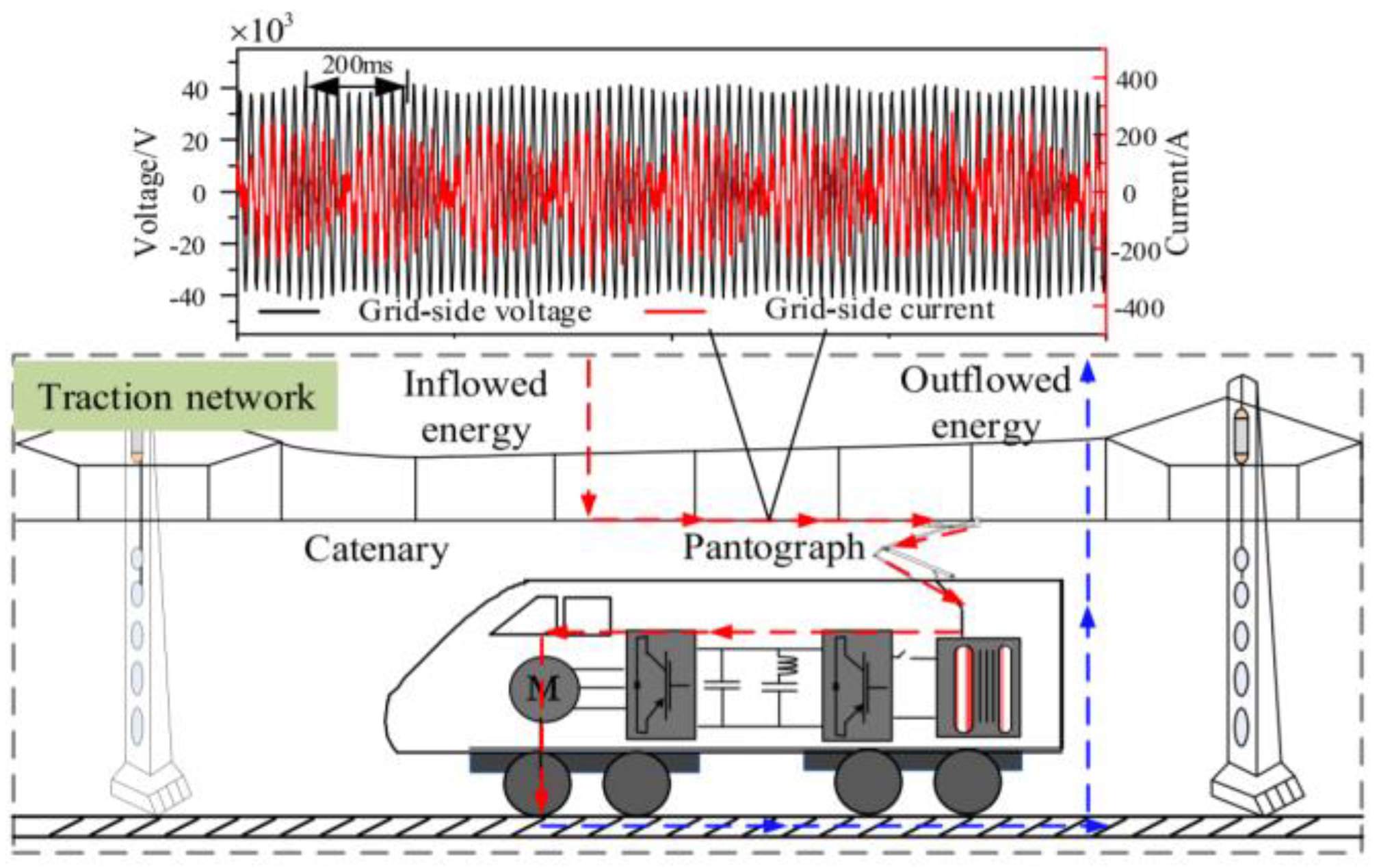
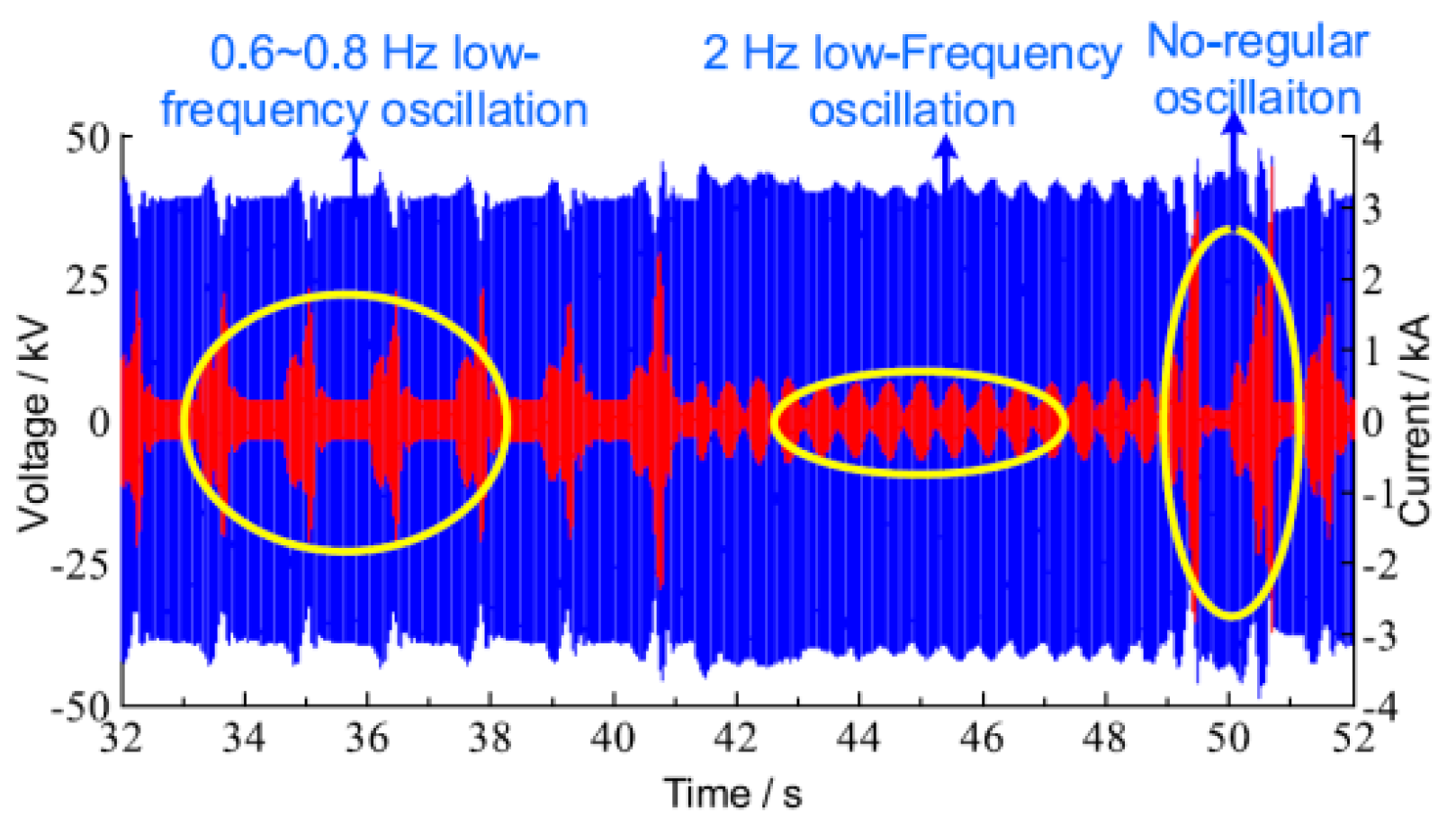



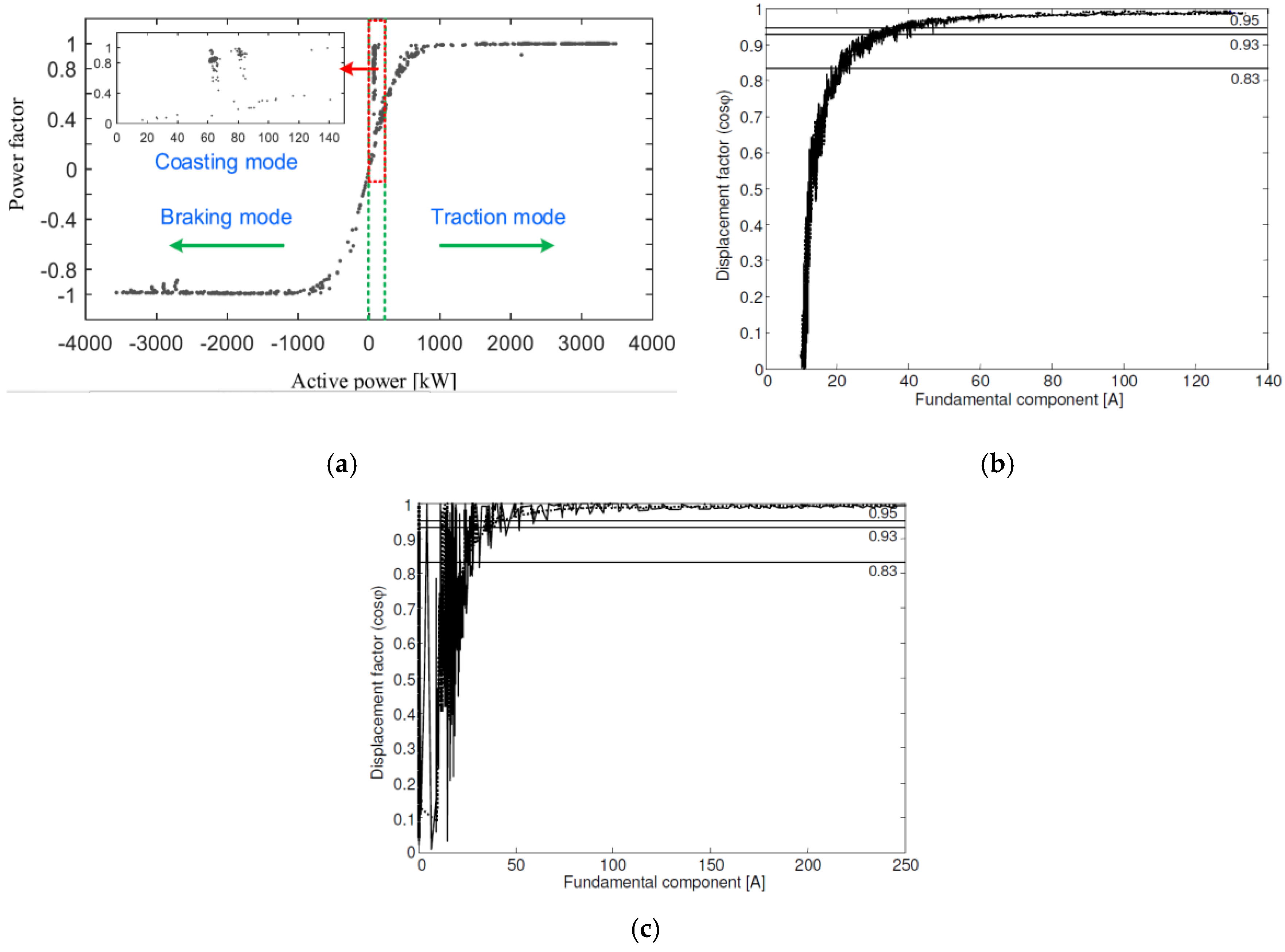


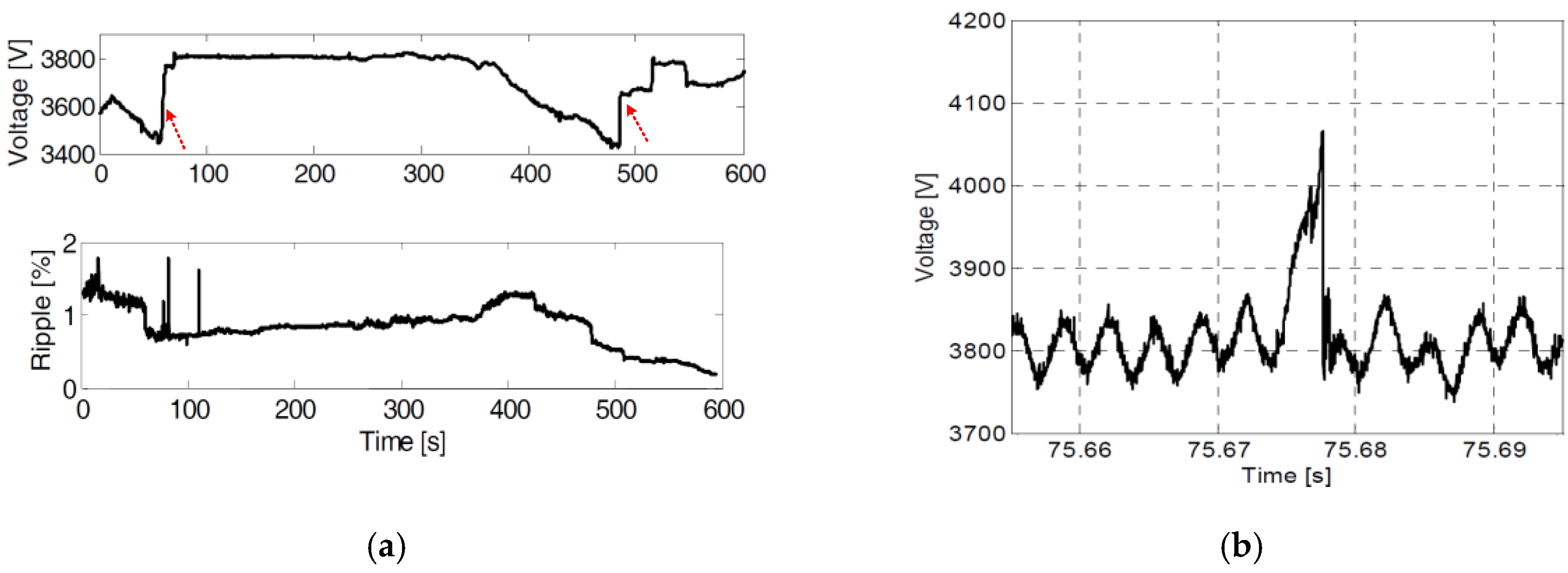



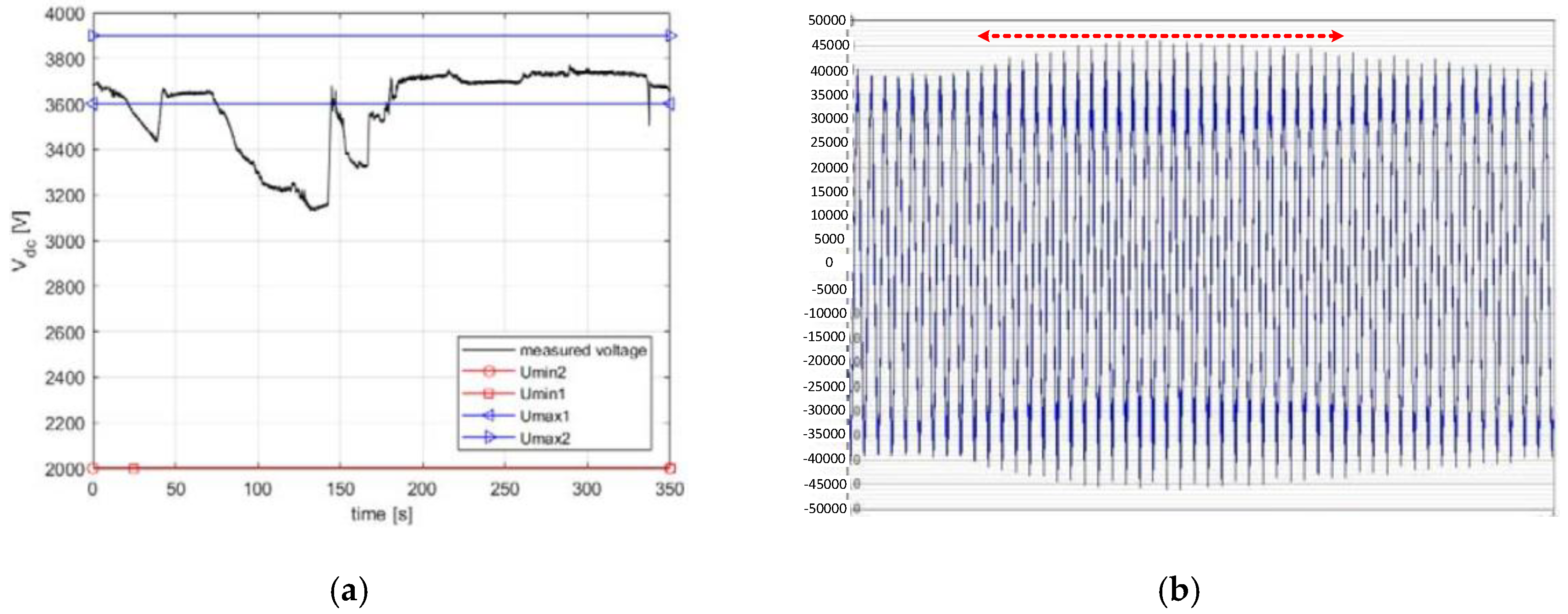


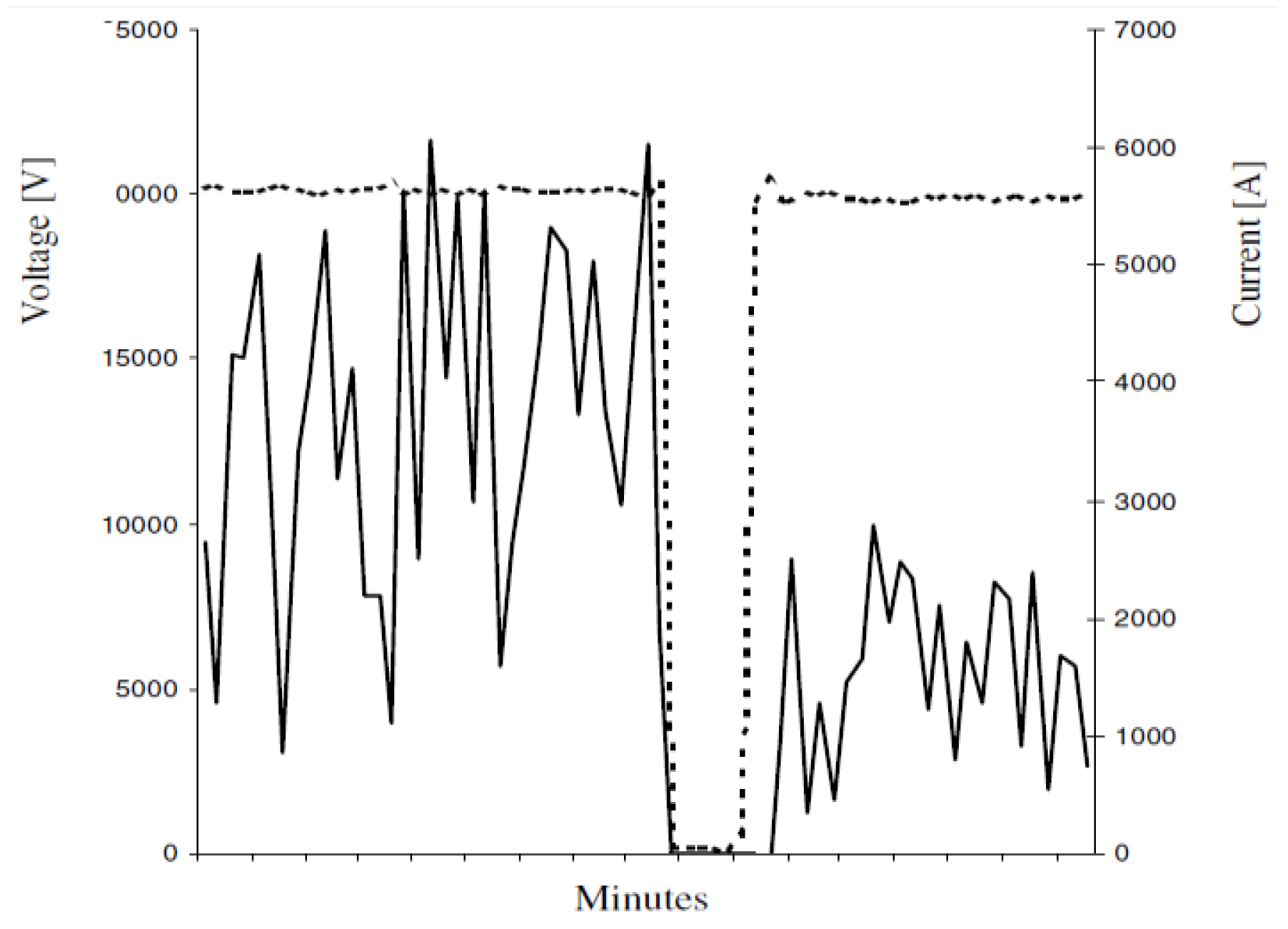
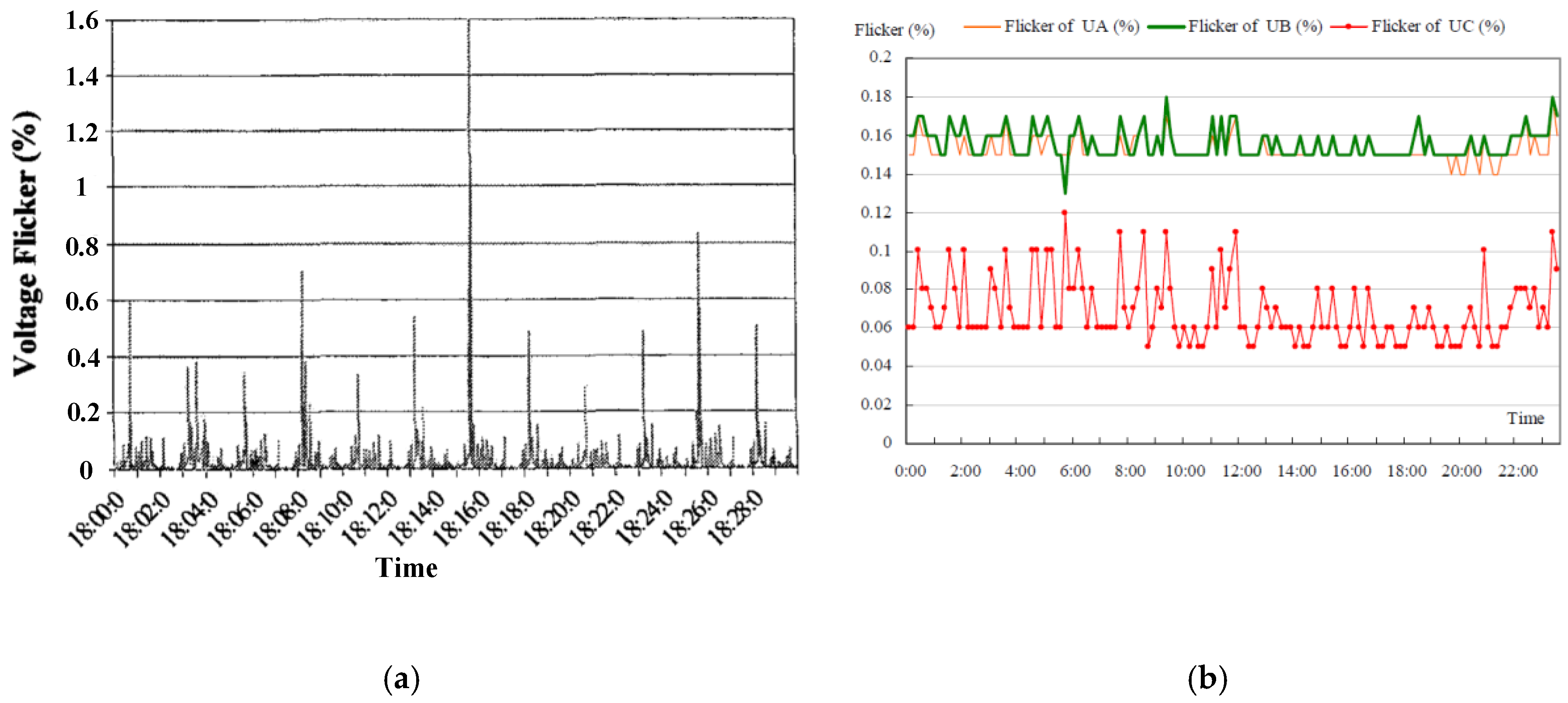
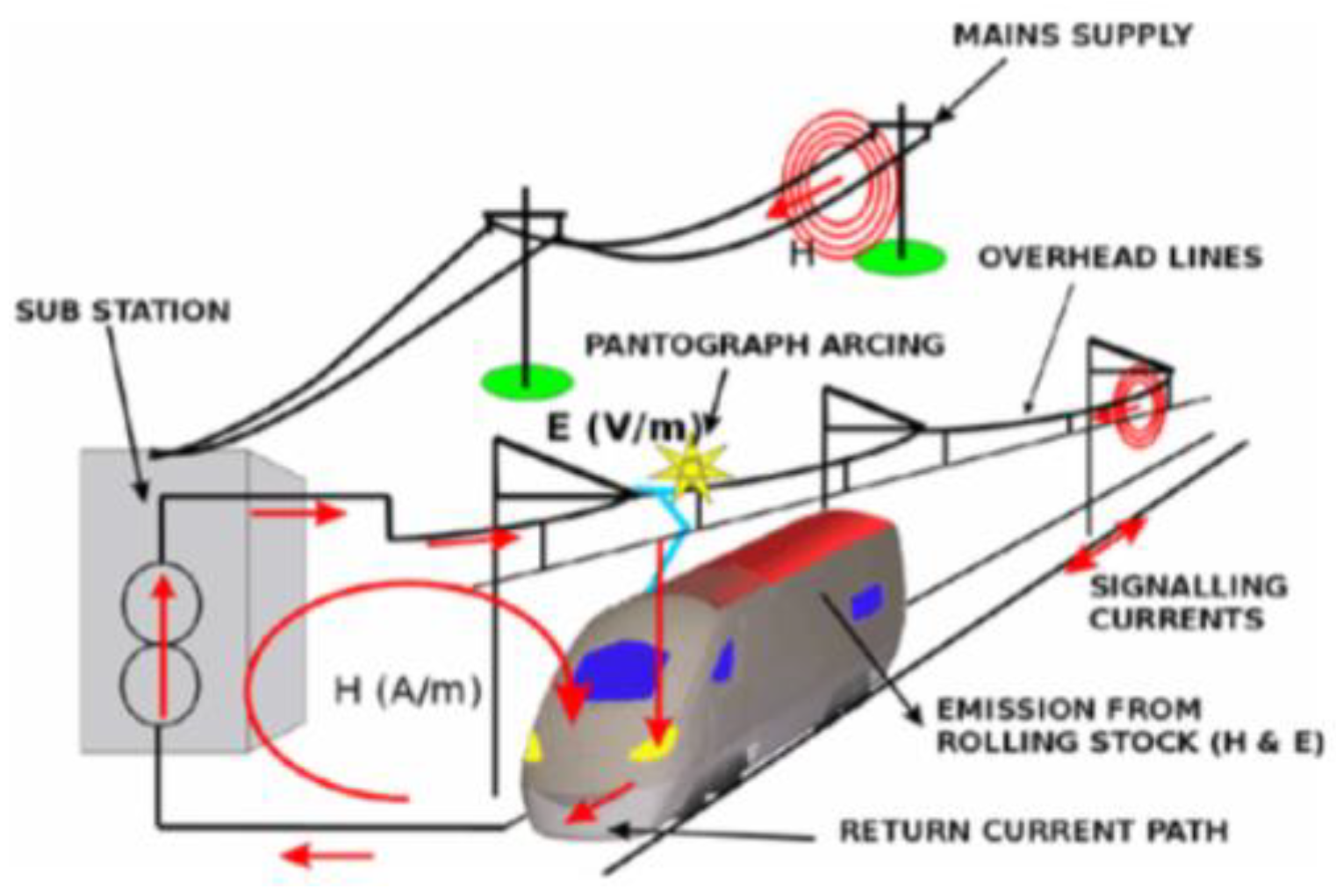

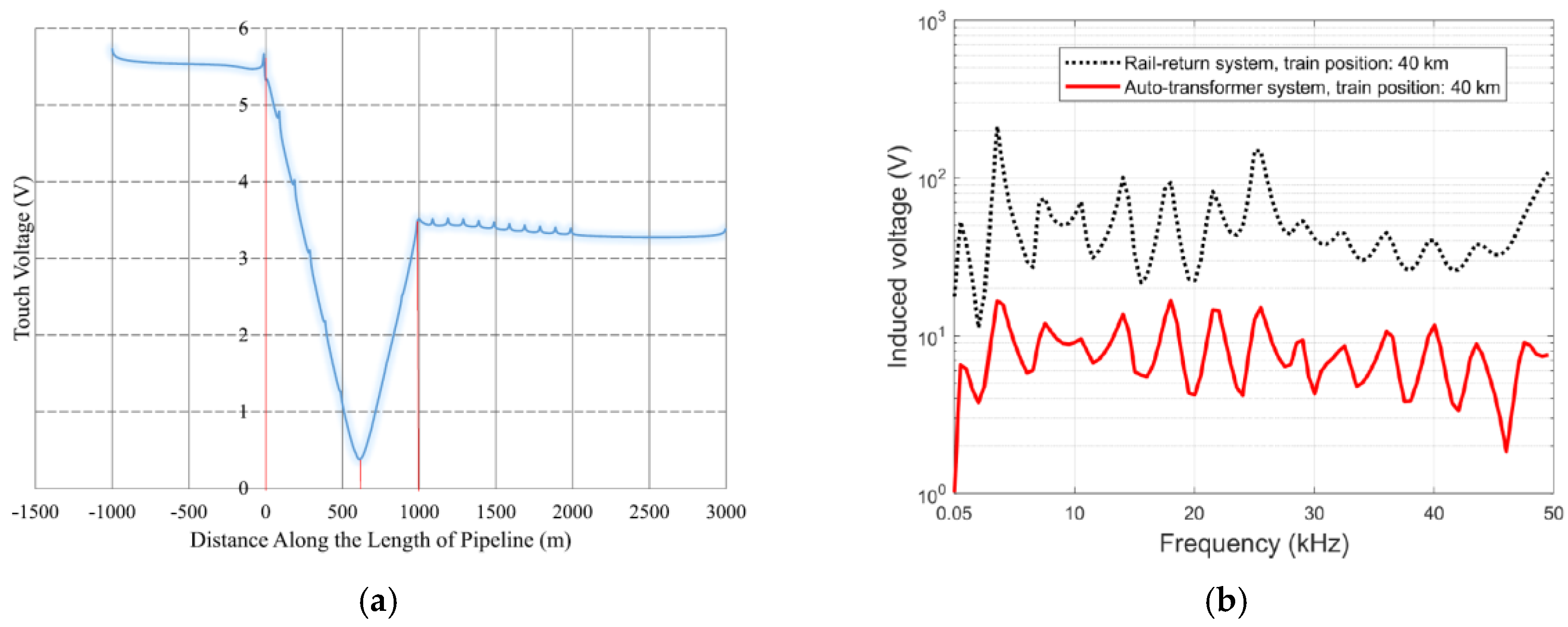




| No. | Type of HR | Frequency Period (p.u) | Location |
|---|---|---|---|
| 1 | Parallel | 15–20, 45–55, 35–59, 50–64 | China [66,67,68,69] |
| 2 | Parallel | 24–30 | Korea [43] |
| 3 | Parallel | 21–29,39,121,139 | Italy [28,70] |
| 4 | Parallel | 20–60 | United Kingdom [71] |
| 5 | Parallel | 49–51 | Thailand [72] |
| 6 | Parallel | 29–41 | Japan [73] |
| 7 | Parallel | Up to 63 | Zimbabwe [74] |
| 8 | Parallel | 13–20 | Czech Republic [75] |
| 9 | Parallel | 21,81 | Iran [76] |
| 10 | Parallel | <25 | Germany [77] |
| 11 | Series | 3–7 | Spain [78] |
| 12 | Series | 64, 72, 80 | Italy [79] |
| Transformer Type | Load Condition | PF1 | PFE | PFV | PFA | Overall |
|---|---|---|---|---|---|---|
| Single-phase | Balanced | high | very low | medium | very low | very low |
| Unbalanced | high | very low | medium | very low | ||
| V/V | Balanced | low | low | high | low | medium |
| Unbalanced | medium | low | high | medium | ||
| Y/d | Balanced | very high | medium | very high | medium | very high |
| Unbalanced | very high | medium | very high | low | ||
| Scott | Balanced | medium | very high | low | very high | high |
| Unbalanced | low | high | low | very high | ||
| Le-Blanc | Balanced | very low | high | very low | high | low |
| Unbalanced | very low | very high | very low | high |
| Phenomena | Type | Causes and Sources | System Type & References |
|---|---|---|---|
| Unbalance | VUF | single-phase power supply, asymmetric faults | AC 1 × 25 kV [30], AC 2 × 25 kV [37,41] |
| CUF | single-phase power supply, asymmetric faults | AC 2 × 25 kV [31,41], AC 1 × 25 kV [33], AC 15 kV-16.67 Hz [36] | |
| Harmonics | LOH | background harmonics, train internal harmonics, DC rectifier substation | AC 1 × 25 kV [24,44,45,46,47], AC 2 × 25 kV [42,43], LVDC [29,48,50], MVDC [49,51] |
| InH | AC motors controlled by variable frequency drives, onboard PWM converters | AC 1 × 25 kV [54,55], 2 × 25 kV [53], 15 kV-16.67 Hz [52], MVDC [53] | |
| LFO | impedance mismatch between the railway network and PWM trains, rotary converter | AC 1 × 25 kV [59,60,61,62], 2 × 25 kV [64,65] 15 kV-16.67 Hz [56,57,58], MVDC [63] | |
| HR | interaction of current harmonics and internal resonance of LC circuit of OCS | AC 1 × 25 kV [71,72,73,74,75], 2 × 25 kV [66,67,68,69,70,76,79], 15 kV-16.67 Hz [77] | |
| HI | interaction between high switching frequency of PWM converters in modern trains and internal resonance of OCS, high-frequency specifications of the closed-loop control system for 4QC | AC 1 × 25 kV [85,86], 2 × 25 kV [80,82,84], 15 kV-16.67 Hz [81,87], MVDC [82] | |
| Low Power Factor | LPF | overlap commutation angel in conventional rectifier, inductive reactance features of the OCS, supplying sections with different phase | AC 1 × 25 kV [89,90,95], 2 × 25 kV [92,93,94], 15 kV-16.67 Hz [88], MVDC [12], LVDC [12,51] |
| Transient events | ImT | lightening, switching of circuit breakers, abnormal changing in tractive efforts, sliding contact between pantograph and OCS, passing neutral zone | AC 1 × 25 kV [99,100], 2 × 25 kV [97], 15 kV-16.67 Hz [98], MVDC [99,102], LVDC [101,102] |
| OsT | changing in operational condition and modulation patterns, sliding contact and pantograph jump over OCS, inrush current of locomotive transformer, capacitor bank energization | AC 1 × 25 kV [106,111], 2 × 25 kV [1], 15 kV-16.67 Hz [105], MVDC [103,104], LVDC [103,104] | |
| Short duration rms variation | Sag | fault occurrence, high current absorbed by traction motors, sudden load changes or supplying high-power locomotives, TPSS transformers energization/de-energization, motor blocking caused by the segregation of pantograph and OCS, neutral sections, TPSS equipment triggering | AC 1 × 25 kV [108,111,112], 2 × 25 kV [110], 15 kV-16.67 Hz [105,109], MVDC [109] |
| Swell | AC 1 × 25 kV [108,111,112], 2 × 25 kV [110], 15 kV-16.67 Hz [105,109], MVDC [109] | ||
| InR | train passes NZ, pantograph bounce operating of the circuit breaker, failure, and fault, abruptly disconnection between the contact wire and pantograph | AC 1 × 25 kV [108,109,112,113], 2 × 25 kV [108,113], 15 kV-16.67 Hz [109], MVDC [109], LVDC [3,114] | |
| Long duration rms variation | OvG | regenerative braking and lack of consumer trains, resonance, system instabilities, passing of neutral zones, lightning, switching or other atmospheric phenomena, functioning of split-phase breakers | AC 1 × 25 kV [99,115], 2 × 25 kV [12,116], 15 kV-16.67 Hz [6], MVDC [117], LVDC [117,118] |
| UvG | Type of line (unilateral, bilateral, …), high traffic of line, resonance, system instabilities, passing of neutral zones, | AC 1 × 25 kV [122], 2 × 25 kV [120,121], 15 kV-16.67 Hz [123], MVDC [1,122], LVDC [1,117,122] | |
| InRS | Train passes NZ, pantograph bounce operating of the circuit breaker, failure, and fault, abruptly disconnection between the contact wire and pantograph | AC 1 × 25 kV [108,109,112,113], 2 × 25 kV [108,113], 15 kV-16.67 Hz [109], MVDC [109], LVDC [3,114] | |
| Voltage fluctuation (Flicker) | FlK | time-varying specification, abrupt load changes in ERPS, static frequency converters, operation of high-power traction motors, arcing equipment | AC 1 × 25 kV [41,108,124,125], 2 × 25 kV [108], 15 kV-16.67 Hz [124], LVDC [124] |
| Waveform distortion | DC offset | indirect current control method of 4QCs, inequality of the positive and negative half-cycle length in six-step mode control | AC 1 × 25 kV [127,129], 2 × 25 kV [127,129], 15 kV-16.67 Hz [127], MVDC [127], LVDC [128] |
| Notch | power electronics devices, 4QC drives, abruptly disconnection between the contact wire and pantograph | AC 1 × 25 kV [45,71,111], 2 × 25 kV [18,111], | |
| Noise | power electronic devices, control circuits, arcing equipment and traction locomotives with onboard rectifiers, sliding contact between the OCS and the pantograph | AC 1 × 25 kV [100,131,132], 2 × 25 kV [100], 15 kV-16.67 Hz [131,132], MVDC [130], LVDC [130,131,132] | |
| Electromagnetic Interference | CEMI | injection of distorted current or harmonics into the power lines from devices with nonlinear features, transient overvoltage originated by switching and atmospheric phenomena, return current flowing through earth | AC 1 × 25 kV [1,134,137], 2 × 25 kV [1,134,137], 15 kV-16.67 Hz [1,137,140], MVDC [1,135,136,145], LVDC [1,135,145] |
| IEMI | Interfacing of magnetic flux related to the source current with a secondary closed system, physical positioning causing transverse emf | AC 1 × 25 kV [1,134,138,139,143,144], 2 × 25 kV [1,138,139,142,143,144], 15 kV-16.7 Hz [1,138,140] | |
| EEMI | production of electrostatic electric fields, capacitive interference between closed conductors and earth, the sudden change in voltage or inherent track admittance causing charging and discharging of capacitors or switching semiconductors | AC 1 × 25 kV [1,133], 2 × 25 kV [1,133], 15 kV-16.7 Hz [1,133] | |
| REMI | The interlinkage between the pantograph and contact wire or between the train’s brushes and the third or fourth rail, neutral intersection points | AC 1 × 25 kV [1,143], 2 × 25 kV [1,143], 15 kV-16.7 Hz [1], MVDC [103,136,145], LVDC [103,145] |
Publisher’s Note: MDPI stays neutral with regard to jurisdictional claims in published maps and institutional affiliations. |
© 2020 by the authors. Licensee MDPI, Basel, Switzerland. This article is an open access article distributed under the terms and conditions of the Creative Commons Attribution (CC BY) license (http://creativecommons.org/licenses/by/4.0/).
Share and Cite
Kaleybar, H.J.; Brenna, M.; Foiadelli, F.; Fazel, S.S.; Zaninelli, D. Power Quality Phenomena in Electric Railway Power Supply Systems: An Exhaustive Framework and Classification. Energies 2020, 13, 6662. https://doi.org/10.3390/en13246662
Kaleybar HJ, Brenna M, Foiadelli F, Fazel SS, Zaninelli D. Power Quality Phenomena in Electric Railway Power Supply Systems: An Exhaustive Framework and Classification. Energies. 2020; 13(24):6662. https://doi.org/10.3390/en13246662
Chicago/Turabian StyleKaleybar, Hamed Jafari, Morris Brenna, Federica Foiadelli, Seyed Saeed Fazel, and Dario Zaninelli. 2020. "Power Quality Phenomena in Electric Railway Power Supply Systems: An Exhaustive Framework and Classification" Energies 13, no. 24: 6662. https://doi.org/10.3390/en13246662
APA StyleKaleybar, H. J., Brenna, M., Foiadelli, F., Fazel, S. S., & Zaninelli, D. (2020). Power Quality Phenomena in Electric Railway Power Supply Systems: An Exhaustive Framework and Classification. Energies, 13(24), 6662. https://doi.org/10.3390/en13246662






